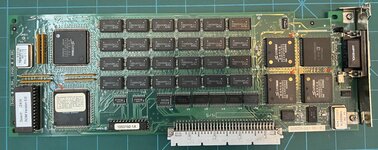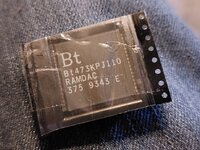jmacz
Well-known member
Recently procured two cards, a Supermac Spectrum/24 Series III + Daughterboard and a Supermac Spectrum/24 Series IV. Both are having some issues and would love to get some second opinions on what else I can try to get them to work.
Supermac Spectrum/24 Series IV
Setup: Quadra 700 and IIci, two Apple 13" RGB Monitors, all machines and monitors have no issues and run fine with onboard video and other video cards.
Card Details: Arrived with ROM version 1.6, card has 14.32MHz and 30.24MHz oscillators.
Issue: At 640x480 @ 24bit color, the display is very feint and very blue in color. At any other bit depth including 8bit color, no image, screen is dark.
Debugging Efforts:
Some Pictures:
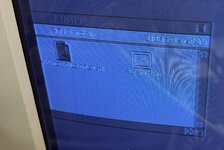
The above is what it looks like at 24bit. Very blue. It's also not entirely in focus, you can see bleeding in the text. If I change to 8bit, 4bit, B&W, I get no image at all.
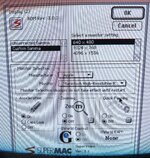
You can see above it's running ROM version 3.0 (again, also tried v1.6). The version 3.0 was for the Spectrum/24 Series V but the other thread on this forum about ROM versions for the SuperMac cards showed that the v3.0 ROM does work on the Series IV and it certainly looks like it does. And the right monitor is selected. Also tried both Custom Gamma and Uncorrected Gamma. Doesn't make a difference.
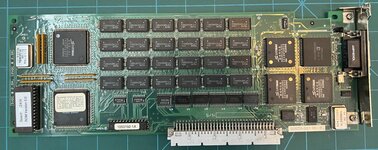
The card. The ROM is my own (with 3.0 on it). Again, both 3.0 and 1.6 have the same issue. The card looks pristine except the white component near the DB15 port. The board has "F12A" printed next to it, and the component itself is labeled "1 1/2 A 125V F 459". Not sure what it is, but there's some board markings near it and it doesn't look to be in good shape. Not sure what it is though. Need to look it up. If someone who has the Series IV can look at their card and tell me what they see, that would be great.
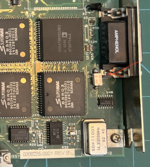
You can see it's not in good shape (pointed at by the red arrow). What's weird is if I go online and find a close up picture of a series IV, I see something different in those pictures:
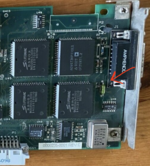
So not sure what to make of it. Of course the card I have is a revision B and the card in the picture above is a revision C.
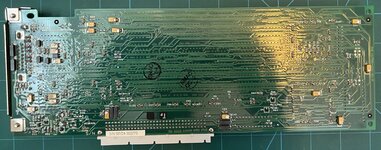
Back of the card looks clean.
Supermac Spectrum/24 Series III + Daughterboard
Setup: Quadra 700 and IIci, two Apple 13" RGB Monitors, all machines and monitors have no issues and run fine with onboard video and other video cards.
Card Details: Arrived with ROM version 1.0, card has 30.24MHz, 64.00MHz, and 80.00MHz oscillators.
Issue: Running at 640x480, and at B&W, 4bit, and 8bit color, the card works great. Seems fast/accelerated. And no issues. But if I flip to 24bit color, the display stops refreshing. The background of windows gets color distorted and if I move windows around, the screen doesn't update. The cursor still shows and can be seen moving, but the windows don't update on screen.
Debugging Efforts:
Some Pictures:
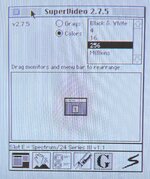
The above picture shows it's a Spectrum/24 series III and this picture was from when it's running the 1.1 ROM. The SuperVideo is v2.7.5 in this picture. As you can see it's fine and running at 8bit (256 colors). Once I click on Millions, I see the below:
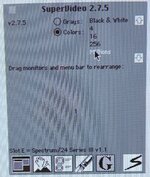
The background changes, window title bar disappears. And if I click and move the window, the screen doesn't update. The window is moved, but the display didn't update so the window is no longer where the image suggests it is. I have to carefully click around the screen until I "find" the window and can switch it back to 256 by guessing where the "256" color option is.

The above is to show that the proper monitor has been selected for my Apple 13" RGB. The screenshot also shows the oscillators installed.

Card is super clean. The picture shows my ROM 1.1 installed in it.
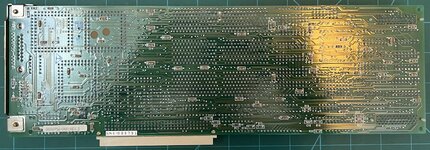
The back is also clean. Card looks great. Don't see any trace issues, no corrosion, etc.
Again, not sure what else to do on this one. If anyone has additional suggestions, I would welcome it. Probably going to try tracing all the connections and checking the solder joints for connectivity next.
Supermac Spectrum/24 Series IV
Setup: Quadra 700 and IIci, two Apple 13" RGB Monitors, all machines and monitors have no issues and run fine with onboard video and other video cards.
Card Details: Arrived with ROM version 1.6, card has 14.32MHz and 30.24MHz oscillators.
Issue: At 640x480 @ 24bit color, the display is very feint and very blue in color. At any other bit depth including 8bit color, no image, screen is dark.
Debugging Efforts:
- ROM Versions: tried ROM version 1.6 which came with the card, also tried ROM version 3.0 (got it from this forum in another thread), both ROM versions exhibit the same issue. Looked at the checksum on the v1.6 ROM and compared against a ROM image of v1.6 from this forum and they match so no corruption.
- Extensions: disabled all extensions and control panels except the Supermac driver and that didn't help.
- Boot Time Configuration: held the Option key down during boot and tried to have the card cycle through the various configurations (the press space bar to select thing) and that didn't help.
- PRAM Reset: reset the PRAM multiple times via command-option-P-R and that didn't help.
- Multiple Machines: tried on both my Quadra 700 and a IIci, and same problems on both.
- Multiple Monitors: tried two different Apple 13" RGB Monitors and same problems on both.
- Multiple DB15 Cables: tried two different DB15 video cables and same problems on both.
- Driver Versions: tried SuperVideo driver versions 2.07, 2.49, 2.74, 2.75, 3.02, 3.1 and same issue on all of them.
- 24bit/32bit Modes: tried in both 24bit and 32bit address modes, didn't help.
Some Pictures:

The above is what it looks like at 24bit. Very blue. It's also not entirely in focus, you can see bleeding in the text. If I change to 8bit, 4bit, B&W, I get no image at all.

You can see above it's running ROM version 3.0 (again, also tried v1.6). The version 3.0 was for the Spectrum/24 Series V but the other thread on this forum about ROM versions for the SuperMac cards showed that the v3.0 ROM does work on the Series IV and it certainly looks like it does. And the right monitor is selected. Also tried both Custom Gamma and Uncorrected Gamma. Doesn't make a difference.

The card. The ROM is my own (with 3.0 on it). Again, both 3.0 and 1.6 have the same issue. The card looks pristine except the white component near the DB15 port. The board has "F12A" printed next to it, and the component itself is labeled "1 1/2 A 125V F 459". Not sure what it is, but there's some board markings near it and it doesn't look to be in good shape. Not sure what it is though. Need to look it up. If someone who has the Series IV can look at their card and tell me what they see, that would be great.

You can see it's not in good shape (pointed at by the red arrow). What's weird is if I go online and find a close up picture of a series IV, I see something different in those pictures:

So not sure what to make of it. Of course the card I have is a revision B and the card in the picture above is a revision C.

Back of the card looks clean.
Supermac Spectrum/24 Series III + Daughterboard
Setup: Quadra 700 and IIci, two Apple 13" RGB Monitors, all machines and monitors have no issues and run fine with onboard video and other video cards.
Card Details: Arrived with ROM version 1.0, card has 30.24MHz, 64.00MHz, and 80.00MHz oscillators.
Issue: Running at 640x480, and at B&W, 4bit, and 8bit color, the card works great. Seems fast/accelerated. And no issues. But if I flip to 24bit color, the display stops refreshing. The background of windows gets color distorted and if I move windows around, the screen doesn't update. The cursor still shows and can be seen moving, but the windows don't update on screen.
Debugging Efforts:
- ROM Versions: tried ROM version 1.0 which came with the card, also tried ROM version 1.1 (got it from this forum in another thread), both ROM versions exhibit the same issue.
- Extensions: disabled all extensions and control panels except the Supermac driver and that didn't help.
- Boot Time Configuration: held the Option key down during boot and tried to have the card cycle through the various configurations (the press space bar to select thing) and that didn't help.
- PRAM Reset: reset the PRAM multiple times via command-option-P-R and that didn't help.
- Multiple Machines: tried on both my Quadra 700 and a IIci, and same problems on both.
- Multiple Monitors: tried two different Apple 13" RGB Monitors and same problems on both.
- Multiple DB15 Cables: tried two different DB15 video cables and same problems on both.
- Driver Versions: tried SuperVideo driver versions 2.07, 2.49, 2.74, 2.75 and same issue on all of them.
- 24bit/32bit Modes: tried in both 24bit and 32bit address modes, didn't help.
- Daughterboard: tried it with the daughterboard connected and disconnected, didn't help.
Some Pictures:

The above picture shows it's a Spectrum/24 series III and this picture was from when it's running the 1.1 ROM. The SuperVideo is v2.7.5 in this picture. As you can see it's fine and running at 8bit (256 colors). Once I click on Millions, I see the below:

The background changes, window title bar disappears. And if I click and move the window, the screen doesn't update. The window is moved, but the display didn't update so the window is no longer where the image suggests it is. I have to carefully click around the screen until I "find" the window and can switch it back to 256 by guessing where the "256" color option is.

The above is to show that the proper monitor has been selected for my Apple 13" RGB. The screenshot also shows the oscillators installed.

Card is super clean. The picture shows my ROM 1.1 installed in it.

The back is also clean. Card looks great. Don't see any trace issues, no corrosion, etc.
Again, not sure what else to do on this one. If anyone has additional suggestions, I would welcome it. Probably going to try tracing all the connections and checking the solder joints for connectivity next.

